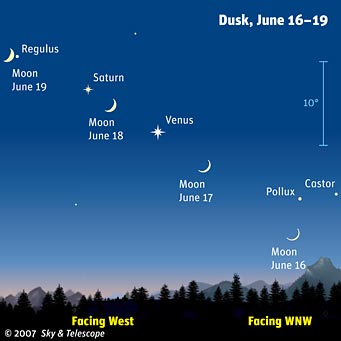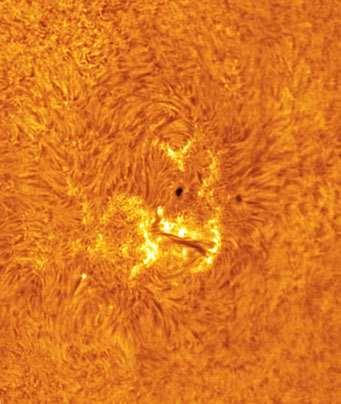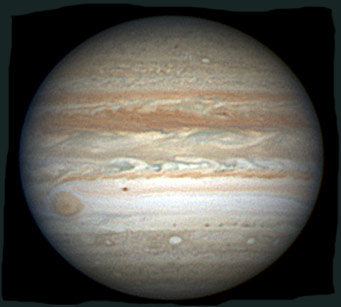Some daily events in the changing sky for June 8 – 16.

Late this week the Moon will return to the evening sky, soon to wax its way up past Venus, Saturn, and Regulus in nightly succession. (These scenes are drawn for the middle of North America. European observers: move each Moon symbol a quarter of the way toward the one for the previous date. The blue 10° scale is about the size of your fist held at arm's length. For clarity, the Moon is shown three times actual size.)
Sky & Telescope diagram
Friday, June 8
Saturday, June 9
Sunday, June 10
Monday, June 11
A list of all the interesting phenomena of Jupiter's moons and their shadows during June, good worldwide, is in the June Sky & Telescope, page 52.
Tuesday, June 12
Wednesday, June 13
Thursday, June 14
Friday, June 15
Saturday, June 16
Want to become a better amateur astronomer? Learn your way around the constellations. They're the key to locating everything fainter and deeper to hunt with binoculars or a telescope. For an easy-to-use constellation guide covering the whole evening sky, use the big monthly foldout map in each issue of Sky & Telescope, the essential magazine of astronomy. Or download our free Getting Started in Astronomy booklet (which only has bimonthly maps).
Once you get a telescope, to put it to good use you'll need a detailed, large-scale sky atlas (set of maps; the standard is Sky Atlas 2000.0) and good deep-sky guidebooks (such as Sky Atlas 2000.0 Companion or the enchanting though dated Burnham's Celestial Handbook). Read here how to use them most effectively.
More beginners' tips: "How to Start Right in Astronomy".
This Week's Planet Roundup

Two small sunspots mark a big active region as revealed in this closeup of the Sun's surface taken in hydrogen-alpha light.
S&T: Sean Walker
The Sun is displaying an interesting magnetic active region. Sky & Telescope's Sean Walker took this image of it in hydrogen-alpha light early on Sunday morning, June 10th, using a hydrogen-alpha Personal Solar Telescope souped up with a 4-inch f/15 lens. In white light (that is, seen through an ordinary safe solar filter), only the two tiny sunspots are visible. As of Monday the 11th they're nearing the Sun's western limb. They will rotate around the limb out of sight in a couple more days. North is up, and celestial east is left.
You can check the appearance of the Sun's spotted face every day through the eyes of the SOHO Observatory.
Mercury (in the feet of Gemini) is dropping down into the glow of sunset and also fading fast. It's down to magnitude 1.5 on the 11th and 2.6 on the 16th. Look for it early in the week, far to the lower right of Venus in early twilight. Bring binoculars.
Venus (magnitude –4.5, in Cancer) is the brilliant "Evening Star" in the west during and after twilight. After standing high in the dusk all spring, Venus is getting a little lower. To its upper left, Saturn and Regulus are perfectly lined up with it, as shown at the top of this page.
In a telescope, Venus should be just beginning to show a slightly concave terminator, after appearing exactly half-lit last week.
Mars (magnitude +0.8, in Pisces) is gradually getting higher in the east before and during dawn. It's the orange-yellow dot far below the Great Square of Pegasus.
Mars is on its way to a Christmas-season opposition and closest approach to Earth. However, unlike during its past few oppositions, Mars this year will grow to an apparent diameter of only 16 arcseconds.

Jupiter's Great Red Spot is rotating into view around Jupiter's celestial east (following) limb in this June 5th image by Christopher Go. Note the very dark red dot, tiny but persistent, to the Great Red Spot's right in the south component of the now-divided South Equatorial Belt. Large white ovals populate the latitude of the South South Temperate Belt. The festoon activity in the Equatorial Zone continues to show weird variety. North is up.
Jupiter (magnitude –2.6, in southern Ophiuchus) was at opposition on June 5th. It glares low in the east-southeast at dusk and dominates the south by about midnight daylight saving time. Antares, less bright, sparkles 7° to Jupiter's right in early evening, and to its lower right later in the night.
Saturn (magnitude +0.5, in Leo) shines in the west during evening, closing in on dazzling Venus from the upper left. The gap between the two shrinks from 17° to 10° this week. Venus and Saturn are on their way to a close conjunction at the end of June.
Regulus, less bright at magnitude +1.4, is 9° to Saturn's upper left. And look north (upper right) of Regulus by 8° for the 2nd-magnitude star Algieba (Gamma Leonis), a fine telescopic binary.
Uranus (magnitude 5.8, in Aquarius) and Neptune (magnitude 7.9, in Capricornus) are well up in the southeast before the first light of dawn.
Pluto (magnitude 13.9, in the northwestern corner of Sagittarius) is not far from Jupiter in the south late at night. Finder charts for Uranus, Neptune, and Pluto are in the July Sky & Telescope, page 60.
All descriptions that relate to your horizon — including the words up, down, right, and left — are written for the world's midnorthern latitudes. Descriptions that also depend on longitude (mainly Moon positions) are for North America. Eastern Daylight Time (EDT) equals Universal Time (UT, UTC, or GMT) minus 4 hours.
To always get the up-to-date Sky at a Glance, bookmark this URL:
http://SkyTonight.com/observing/ataglance .
 0
0
Comments
You must be logged in to post a comment.